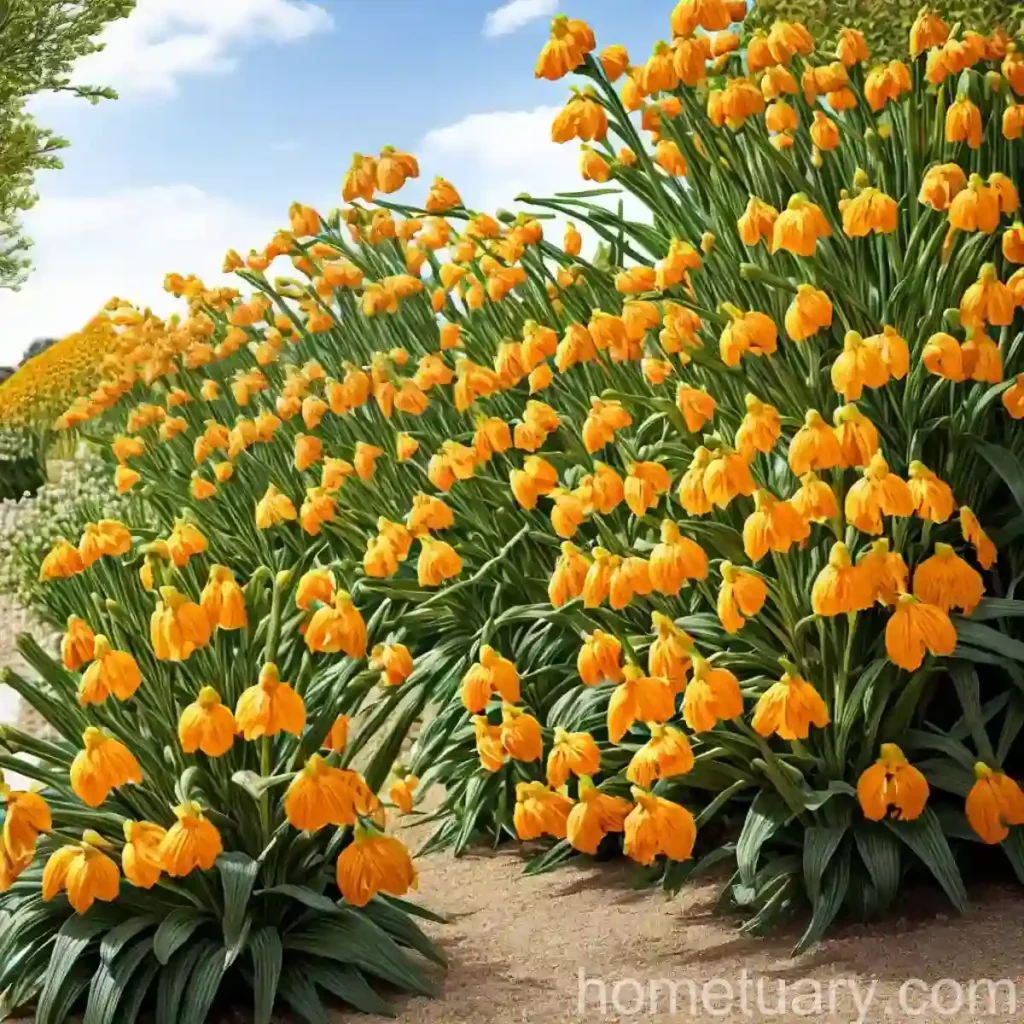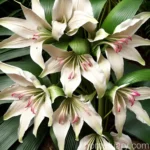The Enigmatic Crown Imperial (Fritillaria imperialis): A Comprehensive Guide
Plants have intrigued humanity for centuries, sparking a passion for exploration and discovery. One such fascinating plant is the crown imperial, scientifically known as Fritillaria imperialis. With its striking flowers and unique cultural significance, the crown imperial captures the attention of plant aficionados and horticulturists alike. In this comprehensive guide, we will delve into the multifaceted world of the crown imperial, exploring its culture, uses, care requirements, and much more.
What is the Crown Imperial (Fritillaria imperialis)?
Crown imperial (Fritillaria imperialis) is a plant species belonging to the family Liliaceae, native to the eastern Mediterranean, from Turkey, Jordan, and Lebanon to Iran. It is also widely cultivated in other regions due to its ornamental value and historical significance.
The plant is esteemed for its large, bell-shaped flowers that form a prominent cluster at the top of an imposing stem, often reaching heights of up to three to four feet. The flowers are crowned with a tuft of small leaves, resembling a crown, which gives the plant its regal name, “crown imperial.”
Key Takeaways – Crown Imperial (Fritillaria imperialis)
Culture
- Fritillaria imperialis is native to the eastern Mediterranean, from Turkey, Jordan, and Lebanon to Iran.
- It is widely cultivated for its ornamental value and historical significance.
Uses
- The plant is primarily grown for ornamental purposes in gardens and landscapes.
Water
- The crown imperial prefers well-drained soil and moderate watering. Overwatering should be avoided to prevent root rot.
Sunlight
- It thrives in full sun to partial shade, preferring bright, indirect light.
Fertilizer
- During the growing season, a balanced, all-purpose fertilizer can be applied to promote healthy growth.
Soil
- Well-drained, fertile soil with a slightly acidic to neutral pH is ideal for Fritillaria imperialis.
Pruning
- After flowering, the stem can be cut back to ground level, allowing the plant to conserve energy for the next growing season.
Propagation
- The plant can be propagated from offsets or seeds, but it may take several years for the seedlings to mature and produce flowers.
Container Popularity
- Fritillaria imperialis can be grown in containers, providing an opportunity to appreciate its beauty up close.
Container Common Diseases
- Containers should have proper drainage to prevent waterlogging, which can lead to root rot.
Disease Diagnosis
- Common diseases include fungal infections such as botrytis and rust, which can be managed through proper cultural practices and, if necessary, fungicidal treatments.
Common Pests
- Pests such as aphids, mites, and bulb-feeding insects may target Fritillaria imperialis, necessitating proactive pest management strategies.
Now that we have outlined the key takeaways, let’s delve deeper into the world of the crown imperial and explore its care requirements, propagation methods, potential uses, and much more.
Botanist’s Tips for Cultivating Crown Imperial (Fritillaria imperialis)
Cultivating Fritillaria imperialis successfully requires a nuanced understanding of its specific care requirements. Whether you are a seasoned gardener or a novice enthusiast, the following tips will guide you in nurturing and appreciating the captivating beauty of the crown imperial.
Soil Requirements
The soil for Fritillaria imperialis should be well-drained and rich in organic matter. It thrives in fertile, loamy soil with a slightly acidic to neutral pH. An optimal soil mix can be prepared by combining equal parts of well-draining soil, compost, and perlite or sand to enhance drainage.
Planting Guide
When planting crown imperial bulbs, ensure they are positioned at a depth of around 6 to 8 inches (15 to 20 cm) in the soil. The bulbs should be spaced approximately 12 inches (30 cm) apart to allow for proper development and prevent overcrowding.
Sunlight Needs
Crown imperial (Fritillaria imperialis) thrives in locations with full sun to partial shade. However, it is essential to provide protection from intense midday sun, especially in hotter climates, to prevent scorching of the foliage and flowers.
Water Requirements
Moderate watering is crucial for the health of Fritillaria imperialis. During the growing season, soil should be kept consistently moist but not waterlogged. Overwatering can lead to root rot, while underwatering can affect the plant’s vigor and flowering potential.
Fertilization
An application of a balanced, all-purpose fertilizer in early spring can provide the necessary nutrients for healthy growth and flowering. A slow-release fertilizer or well-diluted liquid fertilizer can be used according to the manufacturer’s instructions.
Pruning and Maintenance
After the flowering period, the stem of the crown imperial can be cut back to ground level. This pruning practice allows the plant to redirect its energy towards bulb development and storage, promoting future flowering.
Winter Care
In regions with cold winters, a layer of mulch can be applied over the bulb bed to provide insulation and protect the plant from freezing temperatures. This is particularly important for newly planted bulbs and those in exposed locations.
Pest and Disease Management
Regular monitoring for pests such as aphids, mites, and bulb-feeding insects is essential. Additionally, keeping the surrounding area free from debris and ensuring good air circulation can help prevent fungal diseases such as botrytis and rust.
Now that we have covered the essential care tips for cultivating Fritillaria imperialis, let’s explore its propagation methods and potential uses in landscaping and horticulture.
Propagation of Crown Imperial (Fritillaria imperialis)
Crown imperial (Fritillaria imperialis) can be propagated using two primary methods: division of offsets and seed propagation. Both approaches have their unique considerations and timelines for successful establishment and flowering.
Propagation from Offsets
When dividing offsets, it is essential to choose mature, healthy offsets attached to the main bulb. The removal and planting of offsets are typically carried out in late summer to early autumn, allowing the new bulbs to establish themselves before the onset of winter.
Seed Propagation
Propagation from seeds requires patience and a long-term perspective, as it may take several years for the seedlings to reach maturity and produce flowers. The seeds should be sown in well-drained, fertile soil in early autumn, and they will require a period of cold stratification to break dormancy before germination.
Potential Uses in Landscaping
Crown imperial (Fritillaria imperialis) holds considerable potential for ornamental and architectural landscaping. Its tall, stately stems and vibrant flowers make it an excellent choice for adding vertical interest to garden borders, formal landscapes, and naturalistic plantings.
Companion Planting
When incorporating Fritillaria imperialis into a garden or landscape design, consider companion plants that complement and enhance its visual impact. Perennials such as daffodils, tulips, and irises can create stunning color contrasts and harmonious combinations when interplanted with crown imperial.
Medicinal and Herbal Uses
Historically, the bulbs of Fritillaria imperialis have been used in traditional medicine for various purposes, including treatment for respiratory ailments and coughs. However, it is essential to note that the plant’s bulbs contain toxic compounds and should not be consumed without expert guidance.
Symbolism and Ornamental Value
In addition to its ornamental appeal, Fritillaria imperialis carries symbolic significance in different cultures. Its regal stature and striking appearance often symbolize royalty, authority, and beauty, making it a favored subject for floral arrangements, events, and ceremonies.
Wildlife Attraction
The flowers of Fritillaria imperialis can attract pollinators such as bees and butterflies, enhancing biodiversity and contributing to the ecological balance of garden ecosystems.
By understanding the propagation methods and potential uses of Fritillaria imperialis, gardeners and horticulturists can harness the plant’s unique attributes to create captivating landscapes and promote biodiversity.
Unveiling the Captivating Aspects of Crown Imperial (Fritillaria imperialis)
As we continue our exploration of the crown imperial, let’s delve into some lesser-known aspects of the plant and unravel the captivating elements that make it a treasured gem in the world of horticulture and botanical fascination.
Natural Habitat
In its native range, Fritillaria imperialis can be found in diverse habitats, including open woodlands, rocky slopes, and meadows. This adaptability underscores its resilience and ability to thrive in various growing conditions.
Color Variations and Blooming Season
The flowers of Fritillaria imperialis exhibit an impressive array of colors, ranging from vibrant oranges and deep reds to creamy yellows and striking greens. The blooming season typically occurs in spring, adding a spectacular burst of color to garden landscapes.
Fragrance and Flower Arrangements
The flowers of Fritillaria imperialis exude a subtle, sweet fragrance, adding an olfactory dimension to their visual allure. They are prized for their use in elegant floral arrangements and can serve as captivating focal points in indoor and outdoor displays.
Garden Maintenance and Landscape Design
In garden maintenance, the tall, imposing presence of Fritillaria imperialis calls for thoughtful integration into the overall landscape design. Consider its growth stages, bloom heights, and foliage characteristics when planning garden layouts and outdoor spaces.
Hybrid Varieties and Cultivation
Horticultural enthusiasts and breeders have developed numerous hybrid varieties of Fritillaria imperialis, offering a diverse range of colors, sizes, and flower forms. The cultivation of these hybrids presents exciting opportunities for experimentation and innovation in garden settings.
Photography Tips and Garden Themed Events
Photographing Fritillaria imperialis can capture its stunning beauty and architectural elegance. Whether in the garden or as part of themed events, the plant provides captivating visual material for photography and serves as a focal point for garden-themed gatherings.
History and Origin
The historical and cultural significance of Fritillaria imperialis spans centuries, with references in art, literature, and folklore. Exploring its rich history and origin can provide a deeper appreciation for its enduring allure and symbolic resonance.
As we uncover the multifaceted aspects of Fritillaria imperialis, we gain a profound understanding of its cultural, historical, and horticultural significance, elevating it to a revered position in the world of plants and botanical fascination.
Embracing the Enchantment of Crown Imperial (Fritillaria imperialis)
In our journey through the captivating world of Fritillaria imperialis, we have encountered its regal bearing, vibrant flowers, and rich cultural significance. This plant, with its ornamental allure and historical resonance, continues to enchant and inspire gardeners, botanists, and admirers of natural beauty worldwide.
In fostering an appreciation for the crown imperial, we celebrate its botanical splendor, embrace its use in horticulture and landscape design, and honor its historical and cultural legacy. By cultivating Fritillaria imperialis and allowing its regal presence to grace our gardens, we forge a timeless connection to the essence of nature’s captivating wonders.
It is through the exploration and understanding of plants such as Fritillaria imperialis that we unravel the tapestry of nature’s marvels, each unveiling a new layer of enchantment and fascination.
Links to External Resources
- Royal Horticultural Society – Fritillaria imperialis
- Missouri Botanical Garden – Growing Imperial Fritillaria
- University of California, Davis – Fritillaria imperialis: Crown Imperial
- North Carolina State University Extension – Crown Imperial in the Garden
- The American Society of Plant Biologists
- The Royal Botanic Gardens, Kew
- The Botanical Society of America
In our exploration of Fritillaria imperialis, we have unveiled the captivating allure and multifaceted character of the crown imperial. From its regal presence in gardens to its historical significance and cultural symbolism, this plant continues to captivate and inspire.
Through dedicated care, thoughtful cultivation, and a profound appreciation for nature’s wonders, we can honor the legacy of Fritillaria imperialis and create enduring connections to its botanical enchantment.
As we conclude our comprehensive guide to the crown imperial, I invite you to embark on your journey of discovery, embracing the enchantment of Fritillaria imperialis and fostering a deep-rooted reverence for the enduring marvels of the natural world.
Happy gardening and botanical explorations!
References
Please visit the following references for more detailed information:
- Royal Horticultural Society – https://www.rhs.org.uk/plants/101747/fritillaria-imperialis/details
- Missouri Botanical Garden – https://www.missouribotanicalgarden.org/PlantFinder/PlantFinderDetails.aspx?taxonid=287777
- University of California, Davis – https://pbg.ucdavis.edu/plant/fritillaria-imperialis
- North Carolina State University Extension – https://plants.ces.ncsu.edu/plants/fritillaria-imperialis/
- The American Society of Plant Biologists – https://aspb.org/
- The Royal Botanic Gardens, Kew – https://www.kew.org/
- The Botanical Society of America – https://cms.botany.org/















